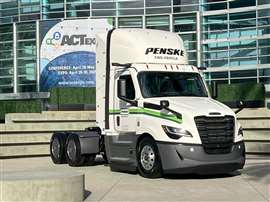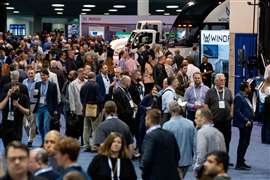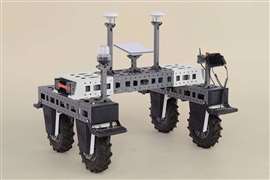Read this article in Français Deutsch Italiano Português Español
Street Smarts: Maybe we needed an emissions regs reset all along
02 June 2025
The reelection of Donald Trump as President of the United States last Fall was a gut punch to climate change activists all over the world.
 ACT Expo attendees were greeted by this CNG-powered Freightliner as they walked into the Anaheim Convention Center. (Photo: Becky Schultz)
ACT Expo attendees were greeted by this CNG-powered Freightliner as they walked into the Anaheim Convention Center. (Photo: Becky Schultz)
We’re only five months into the second Trump administration, but the President and the (just-ever-so-barely) Republican majority in Congress have already begun rolling back diesel exhaust emissions regulations spearheaded by the California Air Resource Board (CARB) and backed by the U.S. Environmental Protection Agency (EPA).
Say what you will about CARB, it clearly knows when it’s beat. On May 7, the agency announced that it was abandoning its controversial and unpopular Advanced Clean Fleets Rules in the face of the proactive Republican moves to roll back environment regulations – led by the state of Nebraska, of all places.
Mood still upbeat at ACT
Given all this, I was curious what the general mood would be heading into the Advanced Clean Transportation Expo (ACT Expo) in Anaheim, Calif., in late April.
ACT Expo has emerged as one of the most important truck/transportation shows in the world over the past decade or so. It’s a show that has an unwavering focus on helping the trucking industry transition away from fossil fuels to a net-zero emissions future.
So, I was naturally curious walking into the Anaheim Convention Center as the show kicked off.
 Despite a concerted effort by the Trump administration to roll back diesel exhaust emissions regulations, the mood at ACT 2025 was upbeat – and even hopeful. (Photo: ACT Expo)
Despite a concerted effort by the Trump administration to roll back diesel exhaust emissions regulations, the mood at ACT 2025 was upbeat – and even hopeful. (Photo: ACT Expo)
Would attendance be down? What would be the mood among exhibitors and attendees? What would be the focus of the show?
As it happened, the show was packed. The mood was decidedly upbeat. OEMs and suppliers had plenty of new, clean and green trucking tech to show off. And there was plenty of new technology still to talk about as well – natural gas as a truck fuel and a sense that the real-world deployment of autonomous trucks is coming soon.
There was a general consensus among industry insiders I talked to that the current emissions rollback was merely a bump in the road on the journey toward a cleaner trucking industry.
CARB’s combustion bias
It’s important to note that the policy makers at CARB are true believers when it comes to combatting climate change, which is why the agency has been pushing a very aggressive agenda that would have completely phased out diesel-powered trucks by 2036. The problem was that CARB also seemed to be suffering from what some industry insiders called “combustion bias.”
As I’ve noted in the past, CARB and EPA (to a lesser extent) appeared to be ignoring excellent transitional fuels – like renewable diesel fuel and renewable natural gas – in favor of new technologies like battery-electric and hydrogen fuel cell-powered trucks.
But there are currently substantial problems with those technologies. Acquisition costs are prohibitive. Infrastructure is virtually nonexistent. And while these powertrains work well in some applications (drayage, urban delivery, short and regional haul), they are nowhere near ready to being a viable option for long-haul fleets.
As I often say, the trucking industry should have been at this point in the war on climate change 20 years ago. So, I get the sense of urgency on the part of environmental regulators.
Yet, it has to be said, the policies CARB was ramrodding down the throat of the trucking industry were an incoherent, unworkable mess.
And turning a deaf ear to the legitimate concerns of the trucking industry while ignoring perfectly viable interim clean fuels like renewable diesel and renewable natural gas was a serious strategic miscalculation on the part of CARB that turned potential allies into intractable adversaries.
Welcome pause
Now, thanks to last Fall’s election, there’s been a reset. And there’s a very real hope out there that this pause will eventually lead to more reasonable and workable climate initiatives that the trucking industry can not only live with but even embrace.
 Jack Roberts is a Tuscaloosa, Ala.-based independent journalist and licensed commercial driver with more than 20 years’ experience covering the North American and global trucking industries.
Jack Roberts is a Tuscaloosa, Ala.-based independent journalist and licensed commercial driver with more than 20 years’ experience covering the North American and global trucking industries.
It will be interesting to see if CARB and other environmental regulators learn anything from this setback.
If nothing else, the coming four years will give OEMs and tech developers more time to develop their zero-emissions solutions. It will also grant more time to get workable electric and hydrogen infrastructure installed and up and running.
My hope is we will also see more movement toward solutions that provide cleaner and reliable fuel solutions that will allow long-haul fleets to continue to profitably move freight while cleaning up the air we breathe.
POWER SOURCING GUIDE
The trusted reference and buyer’s guide for 83 years
The original “desktop search engine,” guiding nearly 10,000 users in more than 90 countries it is the primary reference for specifications and details on all the components that go into engine systems.
Visit Now
STAY CONNECTED




Receive the information you need when you need it through our world-leading magazines, newsletters and daily briefings.
CONNECT WITH THE TEAM












